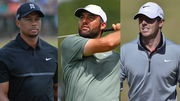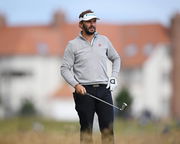

TGL just announced its Season 2 schedule. It returns December 28, 2025, with 15 regular-season matches. Fans are buzzing about Tiger Woods’s comeback. But Adam Scott, a Boston Common team member, just shared something candid. He shed light on TGL’s most significant challenge during a pre-tournament press conference at the BayCurrent Classic in Japan. The 2013 Masters champion didn’t hold back.
Watch What’s Trending Now!
Speaking at Yokohama Country Club on October 7, Scott admitted something most fans probably felt but couldn’t articulate. “I think the scale of it is impressive,” Scott told the media when asked about TGL’s technology. Then came the kicker. “Maybe that’s hard to realize watching on television.”
There it is. The massive 64 x 53-foot screen—24 times larger than standard golf simulators—creates an immersive experience within the 250,000-square-foot SoFi Center in Palm Beach Gardens. That full impact doesn’t quite translate through home screens. However, the scale remains visibly impressive on television, and the format works well for TV viewing. Scott isn’t alone in noticing this gap between in-person and broadcast experiences.
ADVERTISEMENT

USA Today via Reuters
May 19, 2022; Tulsa, OK, USA; Adam Scott plays a shot on the eighth tee during the first round of the PGA Championship golf tournament at Southern Hills Country Club. Mandatory Credit: Orlando Ramirez-USA TODAY Sports
Max Homa experienced this disconnect firsthand. “I thought this too until I went to the arena. It blew my mind,” Homa revealed on social media. The Jupiter Links member admitted he’s “never trusting of how it will come off on TV.” His concern highlights the challenge of capturing arena-level spectacle on a screen.
The scale creates real adjustments for players themselves. Shane Lowry didn’t sugarcoat his biggest challenge. “I keep hitting it too far,” the Irishman admitted after a Bay Golf Club victory. Distance control has forced many pros to recalibrate entirely.
ADVERTISEMENT
Wyndham Clark, Lowry’s teammate, added another layer. “It’s funny; I feel like every team has had something different. Some guys say it doesn’t curve for them,” Clark explained. His squad faced the opposite issue. “We’ve just struggled with our distance.” The simulator reads shots differently from real golf.
Despite this viewing challenge, Scott still encouraged Japanese fans to tune in. “So I would recommend everybody in Japan to check out TGL and hopefully support Boston Common,” he added. His honesty felt refreshing. No corporate spin. Just straight talk about a real issue.
ADVERTISEMENT
Top Stories
Jordan Spieth Loses Crucial PGA Tour Privilege After Unexplained 3-Month Absence

Scottie Scheffler Enters Rare Air With Tiger Woods Through Feat Even Rory McIlroy Never Achieved

Rory McIlroy Confirms Everyone’s Worst Fears With New LIV Golf-PGA Tour Merger Update

Support Pours In for DP World Tour Pro After He Slams New Unfair Changes

Nelly Korda Ties Unwanted Career Record That Tiger Woods Set 15 Years Ago

TGL’s speed factor attracts younger fans
Scott didn’t stop at the scale issue. He dove into what actually makes TGL different from traditional golf. And it’s not just the technology.
“Everything’s happening very fast,” Scott explained. “I think every shot is taken a lot quicker than when we’re playing tournament golf out on the green grass.” The 40-second shot clock keeps players on the move. Traditional golf? Players regularly exceed that without penalties.
ADVERTISEMENT
This pace isn’t accidental. It’s strategic. “I think the speed is exciting and therefore it attracted a lot of new fans, younger fans,” Scott noted. The numbers back him up. Season 1 averaged 513,000 viewers per match. More importantly, 41% fell into the 18-49 demographic. The median age reached 51.9—significantly younger than the traditional golf age of 63.
Scott called it “a completely different style of play” with “a very different atmosphere than what we’re used to.” Matches wrap up in roughly two hours. Compare that to traditional golf’s 4+ hour rounds. The difference is night and day.
Now comes the uncomfortable part. Boston Common went 0-4-1 in Season 1. They finished dead last with just one point. Scott acknowledged this reality head-on.
ADVERTISEMENT
“Boston Common needs to win a match straightaway,” he said. No sugarcoating. No excuses. But he added something interesting. “I think now knowing what to expect, we can do well the next season.”
His teammates? Rory McIlroy, Hideki Matsuyama, and Keegan Bradley. That’s serious star power. Season 1 taught them lessons. Season 2 offers redemption.
“I think doing something completely different was quite enjoyable,” Scott reflected on the inaugural season. “It was fun to be with the other three teammates.” The chemistry exists. Now they need results.
TGL faces an interesting paradox as it heads into Season 2. Its greatest asset—the massive scale and technology—becomes its most significant challenge on TV. Meanwhile, the speed that captivates younger audiences might alienate traditional golf purists.
Can Tiger Woods’s league solve the translation problem? Will Season 2 find the sweet spot between in-person spectacle and TV-friendly viewing? Scott’s candid admission highlighted what everyone is thinking. Now TGL needs to address it.
ADVERTISEMENT
ADVERTISEMENT
ADVERTISEMENT

